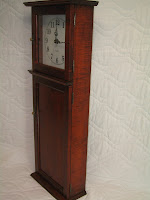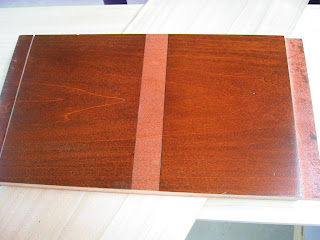Sunday, November 27, 2011
Poplar Lowboy - Cherry Finish Part -2-
Posted by Ace Holeinone at 12:07 PM 0 comments
Monday, November 21, 2011
Poplar Lowboy - Cherry Finish Part -1-
The Test Board...you do those, don't you??????
- Sand the poplar to 180
- Wash-coat is a General Finishes (water-based) High Performance Topcoat mixed in equal parts with water
- Dye is General Finishes (water-based) Cinnamon
- Topcoat is General Finishes High Performance
- Stain is General Finishes (water-based) Black Cherry

The left board in the picture above, is entirely of poplar heartwood. I followed the above procedure sealing the dye over with topcoat. So here is the thing, since the heartwood board will tone or stain darker, due to the fact, poplar heart is darker than the whitish sapwood. The heart wood board will shade about 1 coat darker. So to even out, I had to apply a second coat of stain to the sapwood board.
Posted by Ace Holeinone at 4:54 PM 1 comments
Thursday, November 17, 2011
General Finishes - Crosslinker Additive - Not In Retail Stores
Word on the street is... General Finishes will no-longer sell their additive product called Crosslinker to the retail market. However, still available to the "professional" line of products in quart containers to mostly use in conjunction with General Finishes 450 product line. General Finishes have fortified their products and product lines making crosslinker mostly obsolete.
Crosslinker is an additive product which was sold separately to enrich certain General Finishes products, making then more durable and chemical resistant.
Posted by Ace Holeinone at 11:13 AM 0 comments
Saturday, November 12, 2011
Used LVLP Tool Score - Iwata LPH400-134LV Spray Gun
Posted by Ace Holeinone at 2:49 PM 0 comments
Monday, November 22, 2010
General Finishes Milk Paint
Correct, General Fishes Milk Paint is not that rough old timer Milk Paint made with real cows milk dirt and firewood ashes. That would be like comparing a car to a pickup truck. One’s not better than the other, it just has different features for different jobs.
Yes, it’s acrylic base and is exterior durable, will stick to just about anything and is long lasting. General Finishes Milk Paints are made for wood used in the craft and furniture industry, and for that matter, anything wood. Just a high grade quality furniture paint.
Lets break it down, I believe "Milk Paint" is a term used, like "lacquer." and not Trademarked. Ok think about this, as finishes have evolve, we now must speak in terms of solvent based or water-based "lacquer." Take shellac for example, need to be careful with that! Target Coatings has water-based "shellac." So, correct to say, is your shellac cut with water or alcohol? You bet !
Don't get caught up in the label folks, as I stated earlier, finishes are formulated for different jobs.
Posted by Ace Holeinone at 11:01 PM 0 comments
Wednesday, March 17, 2010
Pine Shaker Clock - The Finish
 I spray 2 to 3 light coats of General Finishes Vintage Cherry water-based dye stain, straight from the can. Once the dye has dried, I begin by wiping the General Finishes water-based Shaker Maple stain over the dyed surface. Should the stain not take to your surface evenly, use paper towels damp with water and wipe the surface to pull the excess stain off. This is probably just a good idea anyway, for even color.
I spray 2 to 3 light coats of General Finishes Vintage Cherry water-based dye stain, straight from the can. Once the dye has dried, I begin by wiping the General Finishes water-based Shaker Maple stain over the dyed surface. Should the stain not take to your surface evenly, use paper towels damp with water and wipe the surface to pull the excess stain off. This is probably just a good idea anyway, for even color.
 Now to the cool part, this allows you to achieve deeper color. First, I shoot a water-based topcoat over the dry Shaker Maple stain. In this case, I'm using the EM6000 production lacquer from Target Coatings and that will amber a bit like solvent nitro lacquer. Second, once the lacquer has dried, I lightly wipe with 320 paper and clean my surface. Then I glaze with the same Shaker Maple stain. So now we have stacked our color, which give's depth to your project and by the same token, will aid to even your color as well.
Now to the cool part, this allows you to achieve deeper color. First, I shoot a water-based topcoat over the dry Shaker Maple stain. In this case, I'm using the EM6000 production lacquer from Target Coatings and that will amber a bit like solvent nitro lacquer. Second, once the lacquer has dried, I lightly wipe with 320 paper and clean my surface. Then I glaze with the same Shaker Maple stain. So now we have stacked our color, which give's depth to your project and by the same token, will aid to even your color as well. Once the stain has dried I shoot 2 coats about 2/3 mils thick (the point where your wet film finish starts to look blue) and call it done.
Once the stain has dried I shoot 2 coats about 2/3 mils thick (the point where your wet film finish starts to look blue) and call it done.Posted by Ace Holeinone at 8:31 AM 0 comments
Labels: Shaker Clock
Monday, March 1, 2010
Tiger Maple Shaker Clock
Tiger maple clock completed. My topcoat is the new General Finishes water based lacquer. Sprayed really nice, laid down flat and smooth. 



Posted by Ace Holeinone at 9:37 PM 0 comments
Labels: Shaker Clock









